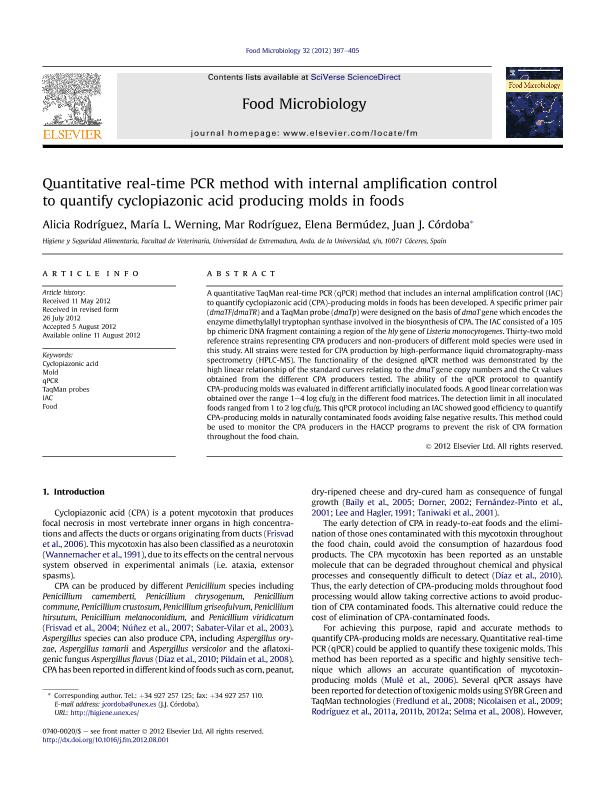Mostrar el registro sencillo del ítem
dc.contributor.author
Rodríguez, Alicia
dc.contributor.author
Werning, María Laura

dc.contributor.author
Rodríguez, Mar
dc.contributor.author
Bermúdez, Elena
dc.contributor.author
Córdoba, Juan J.
dc.date.available
2023-06-05T13:21:03Z
dc.date.issued
2012-12
dc.identifier.citation
Rodríguez, Alicia; Werning, María Laura; Rodríguez, Mar; Bermúdez, Elena; Córdoba, Juan J.; Quantitative real-time PCR method with internal amplification control to quantify cyclopiazonic acid producing molds in foods; Academic Press Ltd - Elsevier Science Ltd; Food Microbiology; 32; 2; 12-2012; 397-405
dc.identifier.issn
0740-0020
dc.identifier.uri
http://hdl.handle.net/11336/199543
dc.description.abstract
A quantitative TaqMan real-time PCR (qPCR) method that includes an internal amplification control (IAC) to quantify cyclopiazonic acid (CPA)-producing molds in foods has been developed. A specific primer pair (dmaTF/dmaTR) and a TaqMan probe (dmaTp) were designed on the basis of dmaT gene which encodes the enzyme dimethylallyl tryptophan synthase involved in the biosynthesis of CPA. The IAC consisted of a 105 bp chimeric DNA fragment containing a region of the hly gene of Listeria monocytogenes. Thirty-two mold reference strains representing CPA producers and non-producers of different mold species were used in this study. All strains were tested for CPA production by high-performance liquid chromatography-mass spectrometry (HPLC-MS). The functionality of the designed qPCR method was demonstrated by the high linear relationship of the standard curves relating to the dmaT gene copy numbers and the Ct values obtained from the different CPA producers tested. The ability of the qPCR protocol to quantify CPA-producing molds was evaluated in different artificially inoculated foods. A good linear correlation was obtained over the range 1-4 log cfu/g in the different food matrices. The detection limit in all inoculated foods ranged from 1 to 2 log cfu/g. This qPCR protocol including an IAC showed good efficiency to quantify CPA-producing molds in naturally contaminated foods avoiding false negative results. This method could be used to monitor the CPA producers in the HACCP programs to prevent the risk of CPA formation throughout the food chain.
dc.format
application/pdf
dc.language.iso
eng
dc.publisher
Academic Press Ltd - Elsevier Science Ltd

dc.rights
info:eu-repo/semantics/openAccess
dc.rights.uri
https://creativecommons.org/licenses/by-nc-sa/2.5/ar/
dc.subject
CYCLOPIAZONIC ACID
dc.subject
FOOD
dc.subject
IAC
dc.subject
MOLD
dc.subject
QPCR
dc.subject
TAQMAN PROBES
dc.subject.classification
Biología Celular, Microbiología

dc.subject.classification
Ciencias Biológicas

dc.subject.classification
CIENCIAS NATURALES Y EXACTAS

dc.title
Quantitative real-time PCR method with internal amplification control to quantify cyclopiazonic acid producing molds in foods
dc.type
info:eu-repo/semantics/article
dc.type
info:ar-repo/semantics/artículo
dc.type
info:eu-repo/semantics/publishedVersion
dc.date.updated
2023-06-02T15:09:55Z
dc.journal.volume
32
dc.journal.number
2
dc.journal.pagination
397-405
dc.journal.pais
Estados Unidos

dc.description.fil
Fil: Rodríguez, Alicia. Universidad de Extremadura. Facultad de Veterinaria; España
dc.description.fil
Fil: Werning, María Laura. Consejo Nacional de Investigaciones Científicas y Técnicas; Argentina
dc.description.fil
Fil: Rodríguez, Mar. Universidad de Extremadura. Facultad de Veterinaria; España
dc.description.fil
Fil: Bermúdez, Elena. Universidad de Extremadura. Facultad de Veterinaria; España
dc.description.fil
Fil: Córdoba, Juan J.. Universidad de Extremadura. Facultad de Veterinaria; España
dc.journal.title
Food Microbiology

dc.relation.alternativeid
info:eu-repo/semantics/altIdentifier/url/https://www.sciencedirect.com/science/article/pii/S0740002012001669
dc.relation.alternativeid
info:eu-repo/semantics/altIdentifier/doi/http://dx.doi.org/10.1016/j.fm.2012.08.001
Archivos asociados
